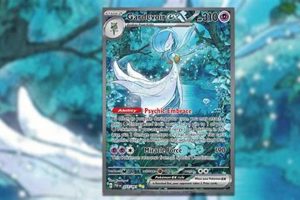A specific characteristic differentiates a small subset of first edition Pokmon trading cards from later print runs. This distinction manifests as the absence of a drop shadow effect behind the illustration window on the card’s face. This lack of shadowing is a key visual cue for identifying these particular cards. An example would be a Charizard from the Base Set; if the card lacks the drop shadow behind the flame illustration, it can be classified accordingly.
The absence of this shadow is significant primarily due to its rarity. These cards were printed during an initial phase of production, before a slight design alteration was implemented. Consequently, they represent a limited segment of the total print run, leading to heightened collectibility and potential value appreciation within the trading card community. This visual feature connects the cards to a specific period in the game’s history.
Understanding this defining characteristic is crucial for collectors and enthusiasts aiming to identify and appraise these Pokmon treasures. Subsequent sections will delve deeper into the specifics of identifying these types of cards, their potential value drivers, and considerations for collecting them.
Identifying a Shadowless Pokmon Card
Careful examination is required to accurately identify a card lacking the drop shadow effect. Subtle details distinguish these cards from later printings.
Tip 1: Visual Inspection of the Illustration Box: The primary method involves inspecting the right and bottom borders of the illustration box on the card’s front. Cards featuring the distinguishing characteristic will exhibit a flat, uninterrupted surface, lacking any indication of a shaded effect.
Tip 2: Compare to Shadowed Examples: Obtain a known shadowed card from the same set. Side-by-side comparison facilitates a clear understanding of the presence or absence of the drop shadow.
Tip 3: Set Symbol Examination: While not directly related to the shadow, confirming the card belongs to the appropriate Base Set or early expansion is critical. Ensure the set symbol (if applicable) matches the expected design for early print runs.
Tip 4: Edition Stamp Verification: If the card is believed to be a first edition, verify the presence and placement of the “1st Edition” stamp. This stamp, coupled with the absence of a shadow, significantly increases the card’s potential value.
Tip 5: Card Condition Matters: The overall condition of the card impacts its collectibility and market value. Examine the card for creases, bends, edge wear, and surface scratches, as these factors can significantly reduce its worth, even if it lacks the shadow.
Tip 6: Reputable Source Confirmation: Consult reputable price guides, online resources, and experienced collectors. Cross-referencing information helps confirm the identity and potential value of the card.
Tip 7: Professional Grading Consideration: For high-value cards exhibiting the feature, consider submitting the card to a professional grading service (e.g., PSA, Beckett). A graded card provides authentication and an objective assessment of its condition, enhancing its marketability.
Accurate identification and condition assessment are vital steps in determining the significance and potential value of this card variation. Applying these tips aids in making informed decisions regarding collecting, selling, or trading these specific Pokmon cards.
These tips provide a foundation for understanding how to correctly identify them. The following sections will delve into aspects of rarity and valuation.
1. Visual Differentiation
The absence of a drop shadow behind the artwork window constitutes the primary visual differentiator for a specific subset of early Pokmon cards. This lack of a shadow effect is not merely an aesthetic detail but a key indicator of a card’s production timeframe. The presence or absence of this shadow provides immediate visual information about the card’s potential rarity and collectibility.
Without visual differentiation, distinguishing early print runs from later, more common printings becomes significantly more challenging. Consider the example of a Base Set Venusaur. If the Venusaur possesses the distinguishing visual trait (absence of shadow), it can be identified as belonging to an earlier, potentially rarer, production cycle. Conversely, a Venusaur with the presence of the drop shadow suggests a later, more common printing. This visual cue provides a practical and immediate means of classification.
Effective visual differentiation is paramount for accurately assessing the potential value and historical significance of these cards. While other factors, such as condition and the presence of a “1st Edition” stamp, contribute to value, the initial visual assessment focusing on the presence or absence of the shadow provides a crucial starting point. Challenges remain in consistently identifying subtle variations, but a firm grasp of this visual distinction is fundamental to navigating the world of collecting these specialized Pokmon cards.
2. First Edition Rarity
The concept of “First Edition Rarity” is intrinsically linked to certain traits. The absence of a shadow behind the illustration window on select Base Set Pokmon cards often coincides with the “1st Edition” designation. This co-occurrence is not coincidental; rather, it is a direct consequence of the printing process during the initial release of the Pokmon Trading Card Game. Cards from the first print runs of the Base Set typically lack the shadow effect and, when present, feature the “1st Edition” stamp, indicating their position in the chronological order of production. For example, a Base Set Charizard identified by its absence of a shadow and the presence of the “1st Edition” stamp gains significant value due to its relative scarcity within the entire population of Charizard cards. This rarity underscores the importance of “First Edition Rarity” as a key component in determining the collectibility and market value of these specific cards.
The practical significance of understanding this connection lies in the accurate identification and valuation of Pokmon cards. Collectors and investors leverage this knowledge to differentiate between more common cards and those with potential investment value. Misidentification can lead to overpayment for cards that do not possess both the “First Edition” stamp and the shadowless characteristic. Consider the case of a collector encountering a Base Set card with the “1st Edition” stamp but also featuring the drop shadow effect. This indicates a later print run of the “First Edition” cards, rendering it less rare and less valuable than its shadowless counterpart. The ability to distinguish these nuances is critical for informed decision-making in the trading card market.
In summary, the association between “First Edition Rarity” and the absence of a drop shadow on certain Pokmon cards is a fundamental aspect of their collectibility and value. The “1st Edition” stamp and the lack of shadowing are indicators of cards from the earliest print runs. While counterfeit or altered cards present ongoing challenges, understanding this correlation enables collectors and investors to make informed assessments and navigate the complexities of the market with greater accuracy. This knowledge is essential for anyone seeking to acquire, sell, or appreciate the historical significance of these trading cards.
3. Early Print Runs
The occurrence of the shadowless characteristic on certain Pokmon cards is directly attributable to the “Early Print Runs” of the Base Set. During these initial production cycles, a design element – the drop shadow effect behind the illustration window – was absent. This absence was not intentional but rather a feature of the production setup at the time. As a result, cards originating from these “Early Print Runs” exhibit this distinguishing trait. These “Early Print Runs” are therefore integral to defining what constitutes a particular variant. A practical example is found by comparing a Base Set Blastoise from an “Early Print Run” to a later printing; the former will lack the shadow, while the latter will possess it. This highlights “Early Print Runs” as a primary causal factor in creating the shadowless variant.
Understanding the link between “Early Print Runs” and the shadowless characteristic has significant practical implications for collectors and investors. Knowledge of this relationship enables informed decisions regarding purchase, sale, and valuation of Pokmon cards. For instance, a collector aware of this connection can accurately identify a potentially rare and valuable card from the Base Set, distinguishing it from more common later printings. Similarly, this understanding informs the pricing strategy for sellers, ensuring that they accurately reflect the scarcity and desirability associated with cards from these “Early Print Runs”. This knowledge helps prevent misidentification and incorrect valuation.
In summary, the shadowless trait is a direct consequence of processes used during “Early Print Runs” of the Base Set. This connection is crucial for identifying, valuing, and appreciating these specific Pokmon cards. While authenticating the exact print run remains a challenge without detailed production records, the absence of a shadow serves as a strong indicator, linking the card to its historical context and contributing to its collectibility. Continued awareness of this connection is essential for participants in the Pokmon trading card market.
4. Base Set Specific
The designation “Base Set Specific” underscores a fundamental limitation regarding cards lacking the drop shadow. This characteristic is almost exclusively associated with cards from the initial Base Set release of the Pokmon Trading Card Game. The design change that introduced the drop shadow occurred relatively early in the production timeline. Consequently, cards from subsequent expansions or revised editions of the Base Set typically feature the shadow effect. A prime example is Charizard. Shadowless Charizards are exclusively found within the Base Set; Charizards from later sets, such as Base Set 2 or Legendary Collection, always include the drop shadow. Therefore, “Base Set Specific” is a critical qualifier when identifying specimens.
The practical implication of “Base Set Specific” lies in efficiently narrowing the search for shadowless variants. Collectors and investors can focus their attention on cards originating from the Base Set, eliminating the need to examine cards from other sets. This targeted approach conserves time and resources. For instance, if one is seeking a shadowless Blastoise, it is unnecessary to inspect Blastoise cards from the Evolutions expansion, as those cards are not “Base Set Specific” and will invariably include the drop shadow. Understanding this restriction streamlines the identification process and improves accuracy.
In summary, the “Base Set Specific” nature is an essential aspect of what defines this type of card. This characteristic limits the occurrence of the feature to a particular set, improving search efficiency and ensuring accurate identification. Acknowledging this restriction is paramount for collectors and investors seeking to acquire or appraise Pokmon cards.
5. Investment Potential
The “Investment Potential” linked to cards exhibiting the shadowless characteristic stems from their inherent rarity and historical significance within the Pokmon Trading Card Game. Their limited availability and the increasing demand from collectors contribute to the asset classs appeal.
- Scarcity and Limited Supply
Shadowless cards represent a finite resource, originating from early production runs of the Base Set. The scarcity of these cards, relative to later printings, creates a supply-demand dynamic that can drive up market values. A shadowless Charizard, for instance, is inherently rarer than its shadowed counterpart, contributing to a significant price differential.
- Historical Significance
As artifacts from the initial launch of the Pokmon Trading Card Game, these cards hold historical value. They represent a specific moment in the game’s history. The “investment potential” derives from the intangible value placed on these relics by collectors. For instance, a shadowless Blastoise acts as a tangible representation of the game’s origins, increasing its desirability and price.
- Grading and Authentication
Professional grading services, such as PSA and Beckett, play a crucial role in validating and assessing card condition. A high grade from a reputable service can substantially increase the “investment potential”. A graded shadowless Pikachu, for instance, provides buyers with confidence in the card’s authenticity and condition, influencing its market value.
- Market Trends and Demand
Market trends and collector demand influence the valuation. Shifts in popularity or renewed interest in vintage Pokmon cards can drive up prices. A sudden surge in demand for specific Pokmon can create a temporary bubble, potentially benefiting those holding specimens. These market forces directly influence the “investment potential” associated with cards.
These factors collectively contribute to the “investment potential” of these cards. However, like any investment, caution and thorough due diligence are essential. Market fluctuations, condition assessments, and authentication are critical considerations for individuals seeking to capitalize on this niche market.
6. Authentication Imperative
The “Authentication Imperative” is paramount when dealing with specific cards, primarily due to their inherent value and the prevalence of counterfeit or altered specimens in the trading card market. The combination of rarity and market demand creates an environment conducive to fraudulent activity. Consequently, verifying the authenticity of a card identified as lacking a drop shadow is not merely a best practice but a fundamental necessity for collectors and investors. Failure to adhere to the “Authentication Imperative” can result in significant financial loss. For instance, a purported first edition Charizard without the shadow, if later proven to be a forgery, would possess negligible value, regardless of its apparent condition.
The practical significance of the “Authentication Imperative” extends beyond the prevention of fraud. Genuine verification of authenticity informs valuation, enabling accurate pricing and facilitating legitimate transactions. Professional grading services provide objective assessments of a card’s authenticity and condition. A card lacking the drop shadow, when authenticated and graded by a reputable service, gains credibility and market acceptance. Conversely, an unauthenticated card, even if seemingly genuine, remains suspect, limiting its marketability and value. The “Authentication Imperative” ensures transparency and confidence in the marketplace.
In summary, the “Authentication Imperative” is inextricably linked to this type of card due to its rarity, value, and susceptibility to fraud. Authentication not only safeguards against financial loss but also informs valuation and fosters confidence within the collector community. While visual inspection provides a preliminary assessment, professional authentication remains the definitive means of establishing legitimacy and maximizing the market potential.
7. Collector's Item
The designation of a card lacking the shadow effect as a “Collector’s Item” is a direct consequence of its scarcity, historical significance, and aesthetic distinctiveness. These features combine to elevate it beyond a mere playing card, transforming it into an object of considerable value within the trading card community. The limited availability of these specimens, originating from early production runs of the Base Set, immediately establishes their rarity. This rarity is then amplified by their association with the inaugural release of the Pokmon Trading Card Game, imbuing them with historical significance. The absence of the drop shadow, a visual anomaly that distinguishes them from later printings, further enhances their appeal to collectors seeking unique and uncommon items. A Base Set Charizard without a shadow, for instance, embodies all of these attributes, making it a highly sought-after “Collector’s Item” with a correspondingly high market value.
The practical significance of recognizing the status as a “Collector’s Item” extends to various aspects of the trading card market. It informs valuation, influencing both buying and selling decisions. Collectors are willing to pay a premium for items they perceive as rare, historically significant, and aesthetically unique. Understanding the factors that contribute to this perception allows collectors to make informed purchasing decisions, avoiding overpayment for misrepresented cards or undervaluing genuine specimens. Similarly, sellers can leverage the “Collector’s Item” designation to accurately price their cards, maximizing their potential returns. Moreover, the recognition fosters a sense of community among collectors, creating a shared appreciation for these unique objects.
In summary, the association with being a “Collector’s Item” is integral to comprehending the value and significance. It arises from a combination of scarcity, historical context, and distinctive visual traits. This understanding informs market transactions, fosters community, and promotes appreciation for these artifacts. While the trading card market presents inherent challenges, such as valuation fluctuations and authentication concerns, the recognition of the “Collector’s Item” status provides a valuable framework for navigating this complex and dynamic environment.
Frequently Asked Questions
The following questions address common inquiries regarding the nature, identification, and value drivers.
Question 1: How can one differentiate a card lacking a shadow from its shadowed counterpart?
The primary visual distinction lies in the absence of a drop shadow effect behind the illustration box on the card’s front. Inspection of the illustration box reveals a flat, uninterrupted surface on a shadowless card, while the shadowed version displays a noticeable shaded effect.
Question 2: Is the absence of a shadow effect limited to specific Pokmon?
No. The lack of the shadow effect is not specific to certain Pokmon species. It is a characteristic of early print runs of the Base Set. Any Pokmon card from the Base Set could potentially exist without the drop shadow.
Question 3: Does the presence of the “1st Edition” stamp automatically guarantee that a card lacks the shadow?
While a strong correlation exists, the “1st Edition” stamp does not guarantee the absence of a drop shadow. Later printings of the First Edition still included the shadow. Both features must be present to maximize potential value.
Question 4: How significantly does the card’s condition affect its value?
Condition significantly impacts the value. Cards exhibiting creases, bends, edge wear, or surface scratches are worth considerably less than those in near-mint or mint condition, even if the card lacks the shadow.
Question 5: Can a card from a set other than the Base Set exhibit the shadowless characteristic?
Extremely unlikely. The shadowless characteristic is virtually exclusive to the Base Set. Cards from subsequent expansions, such as Jungle or Fossil, typically feature the drop shadow effect.
Question 6: Where is the best place to have a card authenticated and graded?
Reputable professional grading services, such as PSA (Professional Sports Authenticator) and Beckett Grading Services (BGS), offer authentication and grading services. Selecting a well-established and recognized service ensures an objective assessment of the card’s authenticity and condition.
In summary, these are primarily early Base Set printings without the now standard drop shadow behind the image.
Following this clarification of common queries, the next section will offer guidance on responsible collection and investment practices.
What is a Shadowless Pokemon Card
The preceding exploration has clarified the characteristics and significance of “what is a shadowless pokemon card.” These cards, originating from early print runs of the Base Set, lack the drop shadow effect behind the illustration window, distinguishing them from later printings. Their scarcity, historical relevance, and unique visual appeal contribute to their status as prized collector’s items, often commanding substantial market value. Authentication and condition assessment remain critical factors in determining their true worth.
The absence of the drop shadow is a marker that connects the card to a specific point in the game’s origin. The trading card market evolves, due diligence in authentication and valuation remains essential. Engaging with reputable resources, experienced collectors, and professional grading services promotes responsible stewardship of these pieces of Pokmon history.







